Drilled Down: The Chemical Weapon Next Door

By Lucy Sherriff
The morning of Wednesday, February 18, 2015, had started just like any other day for Summer Spencer. Back then, she was a sixth grader at South High School in Torrance, a coastal city in the South Bay region of Los Angeles County. But at around 9am, Spencer and her classmates were given a ‘shelter in place’ order by their teacher. It was, the now 17-year-old says, pretty exciting at first. “I just figured I might not have to go to my next class.”
Summer’s teachers closed the doors, secured the windows, and pulled the drapes shut. It was only when she went home that day and spoke to her dad, an environmental safety expert, that she realized she, her classmates, and thousands of other Torrance residents, had had a near miss with a chemical so deadly the Department of Homeland Security lists it as a substance of interest for terrorists.
“I told [my dad] all we did was shut the windows and he explained it wouldn’t have been enough to protect the students,” she recalls.
Spencer’s dad explained if the chemical had been released, “thousands of Torrance residents would have died”.
The threat came from the Torrance Refinery, just three miles away from Summer’s school, a 700-acre plot which processes around 155,000 barrels of crude oil every day, and uses hydrofluoric acid (HF)—or “modified hydrofluoric acid” (MHF) as refineries often refer to the substance—to make high octane gasoline. Around 400,000 people live within three miles of the refineries.
On that Wednesday morning, unbeknown to Summer, pent up gases at the refinery, back then owned by Exxon, had triggered an explosion so big that it registered as a 1.7 tremor. A processing unit had burst open, propelling a large piece of equipment into the air, which narrowly avoided hitting a tank that contained more than 50,000-pound of the deadly HF.
“It was a complete surprise. Nobody really knew the danger of the Torrance refinery,” Spencer told Drilled.

Although the 48 US oil refineries that use MHF claim it is safer than HF, both substances are deadly to humans. And in fact scientists say the two substances are virtually identical. When released, both substances travel in a vapor cloud that can reach eight feet in height, penetrating buildings and causing catastrophic eye, bone, deep tissue, lung and nervous system damage. Essentially, as Torrance-based scientist Dr. Sally Hayati put it, the substance can liquefy your organs.
The substance can liquefy your organs.Dr. sally hayati, describing what leaked HF or MHF can do.
Hayati was alerted to the chemical following the same explosion that piqued Summer’s interest. An engineer with a PhD who formerly had secret clearance for her job at the Aerospace Corporation, Hayati has been investigating the use of HF and MHF in refineries for the past six years. “Now I know what I know, I can’t just turn a blind eye,” she said.
Hayati discovered that MHF is a proprietary substance—meaning its exact makeup is protected as a trade secret—and is nearly identical to HF. “By molecule count, MHF is 99% the same as HF,” Hayati says. “The refineries claim it’s safe. It’s not. It’s a fraud.”
Generally, refineries add a chemical called sulfolane to HF to modify it. The sulfolane is supposed to stop MHF from spreading like a vapor if leaked, but according to Hayati it wouldn’t. Refineries claim their MHF substance is different from HF, insisting there is enough sulfolane added to make MHF safe to use. However, as Hayati points out, the two chemicals are 99% identical, and, like HF, MHF disperses like a cloud if released, which is what makes it so deadly.
The Cybersecurity and Infrastructure Security Agency (CISA) told Drilled if the concentration of HF in the MHF mixture is 50% or greater, the agency would classify the chemical as HF.
The modified HF used in the Torrance and Wilmington refineries has around six to 10% of sulfolane added to reduce the chemical’s volatility, which should prevent the HF from forming a vapor cloud when released. Essentially the sulfolane is intended to ground the HF, keeping it in liquid form, and therefore not a danger to the public. However this amount of sulfolane, Hayati said, is too little a percentage to prevent MHF from exhibiting the same vapor cloud behavior as HF exhibits on release. And there’s another wrinkle: Sulfolane can prevent alkylation units, which are integral in the conversion process from crude oil to high quality gasoline, from properly functioning. According to Hayati, in 1997 the additive caused the MHF unit to malfunction, and the Torrance refinery reverted back to using HF.
“The public was told the MHF unit was successful,” Hayati says. “That was a lie. Quietly, behind the scenes Mobil cut the safety additive and to cover themselves threw in some useless proprietary ‘safety measures’.” [In 2016, the refinery was purchased by PBF Energy.]
That information was revealed in the Consent Decree Safety Advisor’s 1999 report, made after the city of Torrance sued Mobil following an explosion in 1987 that released around 100 pounds of hydrofluoric acid.
The US Chemical Safety and Hazard Investigation Board commissioned a report into the 2015 incident—which very nearly resulted in an MHF tanker being hit by an 80,000-pound chunk of flying debris—but did not recommend the refinery switch to a safer alternative. However, the board noted that ExxonMobil “resisted” requests for safety information pertaining to the potential release of HF.
“ExxonMobil continues to refuse to provide the CSB with information detailing safeguards to prevent or mitigate a release of HF,” the report reads. The CSB has issued subpoenas for this information, and is pursuing enforcement in US Federal district court.” The refinery was later fined $566,600.
In 2019, federal judges ordered ExxonMobil to hand over HF documents, however as of April 2021, that has still yet to happen.
That same year, the CSB wrote to the EPA to say it “strongly encourages” the agency to conduct another study to “determine whether these refineries’ existing risk management plans are sufficient to prevent catastrophic releases.”

Two oil refineries in LA County use HF: the Wilmington refinery, owned by Valero, and the Torrance refinery. Both have fought proposals to ban HF, primarily due to the cost involved in switching to a safer alternative—sulfuric acid—which independent experts estimate would be in the millions of dollars, although the industry argues it would cost almost $1 billion. Alternative technologies that don’t carry the risks of either HF or sulfolane, such as a solid acid catalyst, have been slow to catch on, although in a US-first, Chevron has committed to retrofit its alkylation unit in its Salt Lake City refinery with ionic liquids technology.
Hayati co-founded TRAA—Torrance Refinery Action Alliance—with other community members to argue for a ban of HF and MHF.
South Bay supervisor Janice Hahn is one of the few local officials who has spoken out against the use of HF. “We’re talking about a deadly flesh-eating vapor cloud that could affect 1 million people,” Hahn said.
In April 2019, the Los Angeles County Department of Public Health concluded that MHF should be phased out of the two refineries, as the current healthcare structure is inadequately equipped to respond to the atrocities that would result in the event of a chemical release. However later that year, the South Coast Air Quality Management District killed the push for stronger regulation, instead opting for safeguards that were suggested by the oil refineries themselves, saying “now is not the time” to phase out the deadly acid.
“We’re talking about a deadly flesh-eating vapor cloud that could affect 1 million people.”—South bay supervisor Janice hahn
Drilled spoke to the SCAQMD, which confirmed the board had accepted Valero and Torrance’s voluntary efforts to install safety enhancements.
The Torrance community is supposed to be alerted to an MHF release by a siren—Wilmington does not have one—that is tested every Wednesday. The SCAQMD added the alarm system was “outside the scope of commitments” in the safety enhancement offers made by the refineries. Numerous Torrance residents that spoke to Drilled did not know what the siren meant, and had never heard it before.
In response to the public being unaware of the meaning of the alarms, the spokesperson for the SCAQMD said it had held numerous public meetings concerning HF.
“The South Coast AQMD Governing Board expressed concerns about viable alternatives,” the spokesperson added. “Implementation of the Proffers ensures expeditious safety enhancements instead of requiring a phase out of MHF at this time.”
Refineries elsewhere in the US have experienced HF leaks; in 1987, an HF cloud covered Texas City, prompting the evacuation of 3,000 people across 50 city blocks, and sending 800 to hospital. In 2018, 27,000 people in Wisconsin were evacuated following a refinery fire, as there were fears the HF tank would blow up. In 2019, Philadelphia dodged a catastrophe after more than 5,000 pounds of the chemical was released following an explosion. The CBS again released a sobering statement.
“The board remains concerned that the next time there is a major explosion at a refinery that uses HF for alkylation, workers and those living nearby will not be so lucky,” CBS’s interim executive Kristen Kulinowski said at the time. Philadelphia is now considering a ban on the use of HF in refineries.
In 1986, Dr. Ronald Koopman, a scientist working at government-owned Lawrence Livermore National Laboratory, conducted an experiment in the desert. He wanted to show how deadly HF could be, and filmed the results. Video footage shows 8,300 pounds of HF released within just two minutes, with all of the acid forming a dense, ground-hugging cloud. Even two miles downwind of the release site, the HF cloud still contained more than twice the chemicals needed to kill a person. By contrast, the combined amount of HF held at Torrance and Valero refineries is 829,000 pounds.

“There haven’t been any fatalities, yet. But it’s only a matter of time,” Hayati warned. The location of these refineries, in earthquake-prone Los Angeles County, only adds to the risk. The refineries sit atop the San Andreas fault. “It should be criminally insane…it should be absolutely forbidden to have something so inherently dangerous in an earthquake zone,” Hayati said.
A spokesperson for the Torrance refinery told Drilled the plant has been using the “HF/MHF catalyst” for more than 50 years without ever having an offsite release. The spokesperson noted that HF is used to make refrigerators and other consumer products. They added that alternative alkylation options “have not yet been proven to be safe…or inherently safer than MHF”.
“Therefore,” the spokesperson continued, “MHF remains the safe, proven and superior alkylation technology.”
Summer Spencer’s experience on that Wednesday morning, back in 2015, remained with her for years.
“In hindsight, I would definitely have been scared. Being so young I didn’t comprehend the scale of the danger. I felt other people should know,” she said.
When the opportunity came up with the Girl Scouts to complete a project for her gold award, Spencer knew exactly what she was going to do.
She jumped into action, and began researching how to protect her school from an HF release. She came up with a plan to put up plastic sheeting and duct tape in the classrooms – which CDC guidelines suggest. “We actually found that that doesn’t protect fully either, you actually have to have full face respirators as well,” Spencer added.
Nevertheless, Spencer’s project caught the attention of the Torrance school district, which has since asked the teenager to extend her plan for every school in the district.
“They asked me to write an adaptable protocol for all Torrance schools—around 21 in total. They felt it wasn’t fair to do it for one school and not the rest of them.”
Spencer is now responsible for creating a safety protocol to protect thousands of children, and she is well aware of the pressure.
“I was a little intimidated at first. I never imagined I would be creating an adaptable protocol myself.
Meanwhile, there’s very little happening to regulate HF or MHF nationally. An EPA spokesperson told Drilled by email: “EPA is aware of the concerns raised by various stakeholders regarding the dangers of hydrofluoric acid and the recent history of accidents and near-misses involving hydrofluoric acid alkylation units at refineries. EPA will closely review information regarding these incidents when considering potential regulatory changes.”
In the meantime, the millions of Americans living in the shadow of a potential vapor bomb will continue to rely on refineries to self-regulate, an ineffectual emergency alarm too quiet for anybody to hear, high schoolers to design safety protocols, and community activists to push for better.
This story is part of Covering Climate Now, a global journalism collaboration strengthening coverage of the climate story.
**This story was updated May 18, 2021 with a correction. The original story credited Ms. Hayati with founding the TRAA; she was a co-founder, along with other community members. We regret the error.





